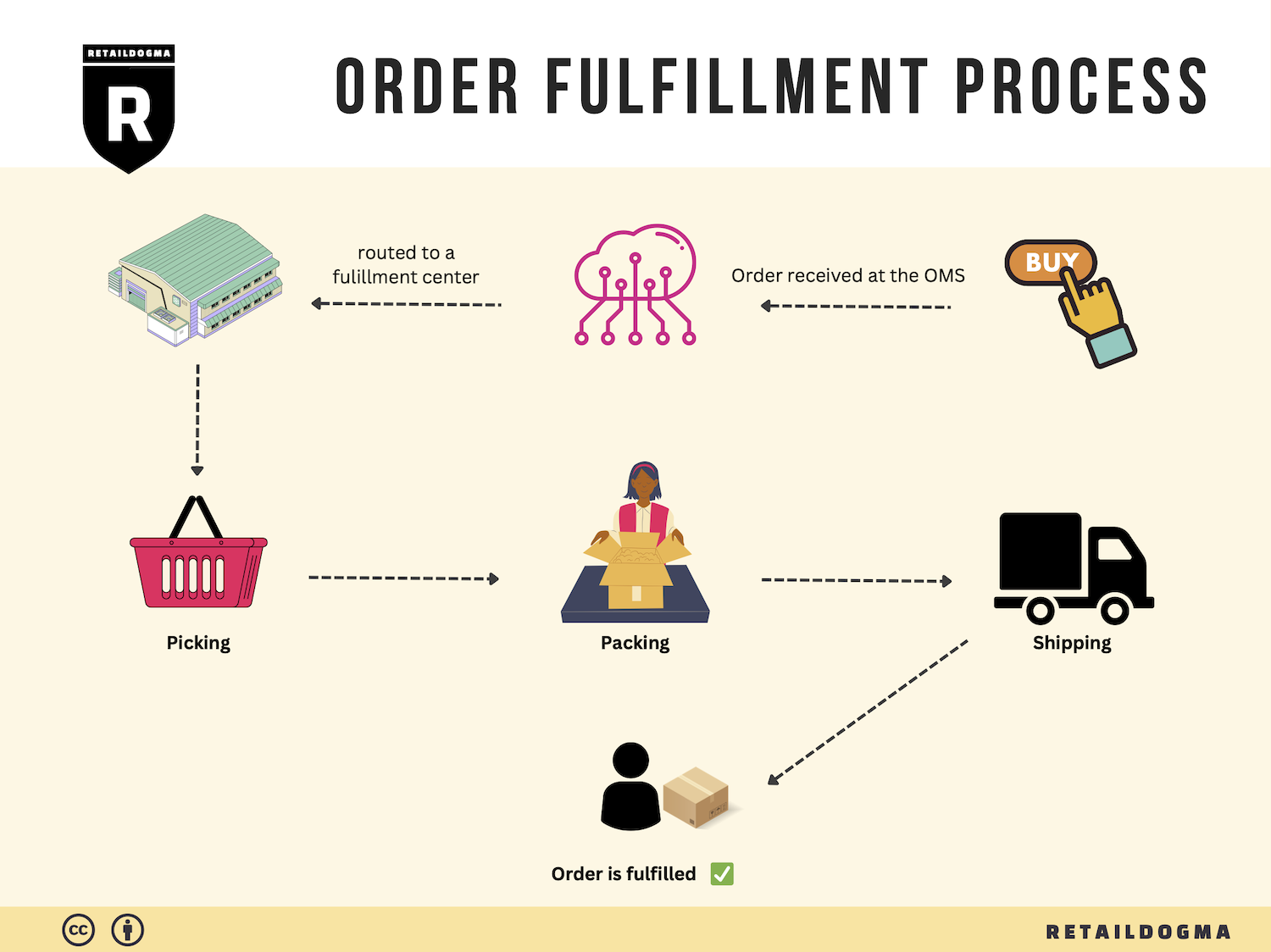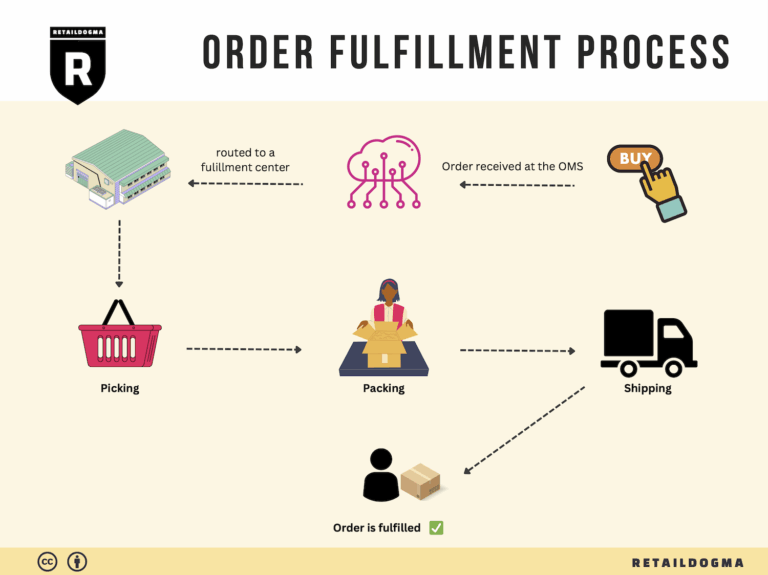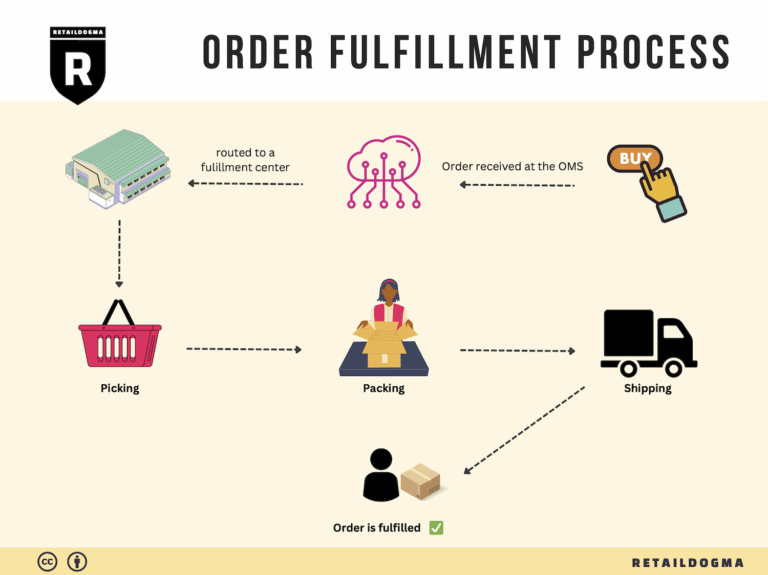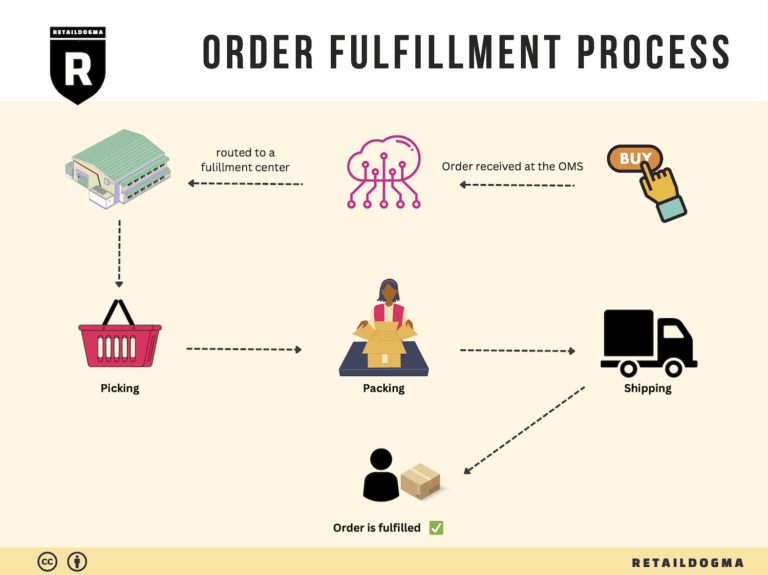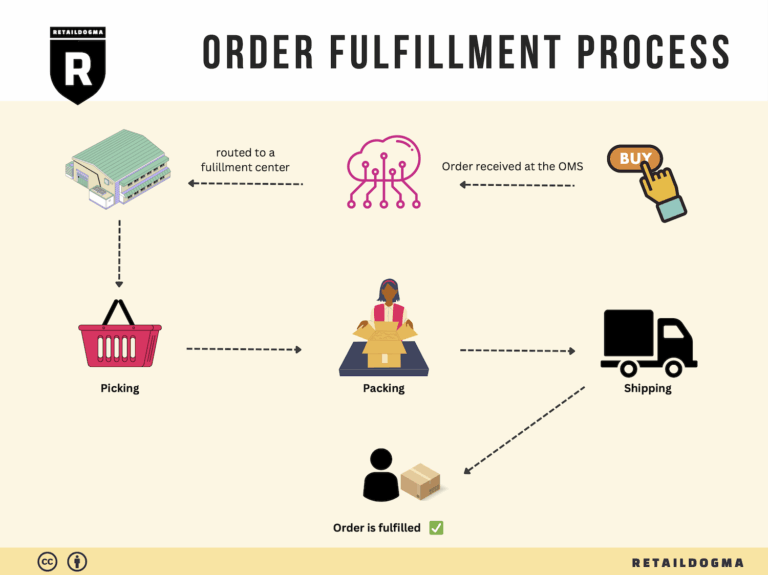What Is A Fulfillment Center? A Complete Guide (2025)
What is E-commerce Fulfillment? An Introduction for Growing Businesses
Understanding E-commerce Fulfillment
As an e-commerce business owner, you may often find yourself overwhelmed by the logistics of packing and shipping orders. This challenge can become especially daunting as your sales grow, leading to potential delays, errors, and dissatisfied customers. At its core, fulfillment is the process of getting a product from your inventory to your customer’s doorstep efficiently and accurately. It encompasses everything from order processing to shipping, and it’s a crucial element of your overall customer experience.
In this guide, we will explore the various models of e-commerce fulfillment available to growing businesses, including Third-Party Logistics (3PL) and Fulfillment by Amazon (FBA). Each model has its unique advantages and considerations, allowing you to choose the one that best aligns with your business goals and operational capabilities.
We will also cover the core services typically offered by fulfillment partners. This includes inventory management, order processing, packing, shipping, and returns management. Understanding these services will help you evaluate potential partners and identify what is essential for your business.
Choosing the right fulfillment partner is a critical decision that can significantly impact your business’s efficiency and customer satisfaction. This guide will provide practical tips on how to assess potential partners based on their capabilities, technology, and customer service. You’ll learn to ask the right questions to ensure that your fulfillment partner can support your growth and adapt to your changing needs.
Additionally, we will discuss pricing structures common in the fulfillment industry. Understanding the costs associated with different models will empower you to make informed financial decisions that align with your budget and growth objectives.
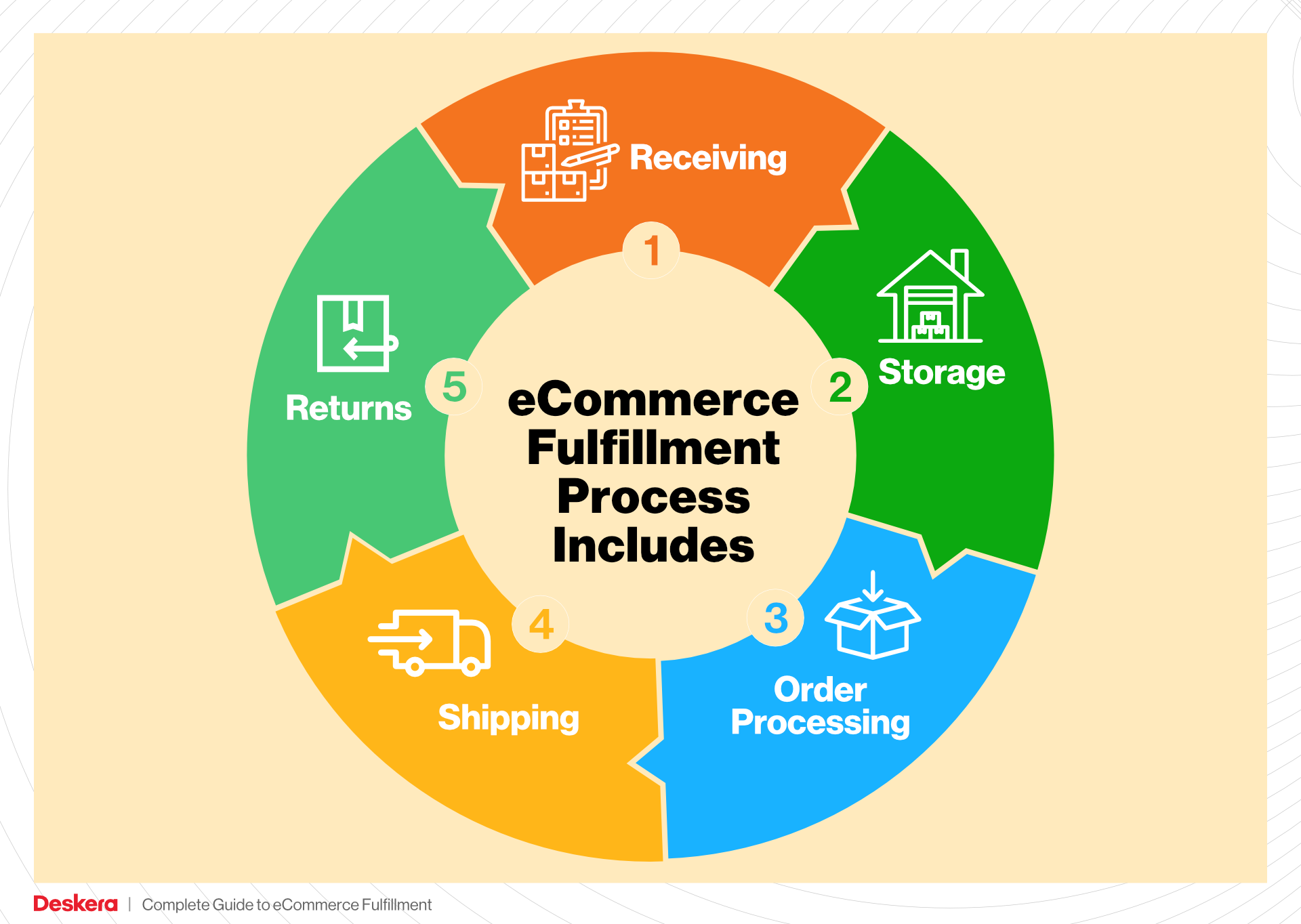
Ultimately, this guide aims to empower e-commerce businesses like yours to make smart, strategic decisions about logistics. By optimizing your fulfillment process, you can improve your operational efficiency, enhance customer satisfaction, and focus on scaling your business without the overwhelm of managing logistics on your own. Whether you’re new to e-commerce fulfillment or looking to refine your existing processes, this guide will provide you with the insights you need to succeed.
What You’ll Learn In This Guide
- What is E-commerce Fulfillment? An Introduction for Growing Businesses
- The Order Fulfillment Process: From ‘Buy’ Button to Customer’s Door
- Comparing Fulfillment Models: In-House vs. 3PL vs. Dropshipping
- A Deep Dive into Amazon FBA: Pros, Cons, and Who It’s For
- Core Services Offered by Fulfillment Centers
- How to Choose a Fulfillment Partner: A 6-Point Checklist
- Understanding Fulfillment Pricing: A Breakdown of Common Fees
- Frequently Asked Questions (FAQs) about Fulfillment
- Conclusion: Is Outsourcing Fulfillment the Right Move for Your Business?
- Important Disclaimer
The Order Fulfillment Process: From ‘Buy’ Button to Customer’s Door
1. Receiving Inventory
The order fulfillment process begins with receiving inventory from suppliers. This step is critical because it ensures that the right products are in stock and available for customers. During this phase, products are checked against purchase orders to confirm quantities and specifications. Each item is assigned a Stock Keeping Unit (SKU), a unique identifier that helps in tracking inventory levels and managing stock efficiently.
The importance of accurate receiving cannot be overstated; discrepancies can lead to stockouts or excess inventory, both of which can harm your business. Implementing a robust inventory management system that utilizes barcoding or RFID technology can streamline this process, allowing for real-time updates on stock levels. By ensuring that inventory is accurately received and recorded, businesses can maintain optimal stock levels and meet customer demand effectively.
2. Warehouse Storage
Once inventory is received, it is stored in the warehouse. Efficient warehouse storage is vital for minimizing retrieval time during order fulfillment. Products should be organized logically, often using a location-based system where items are stored based on their SKU and demand frequency. High-demand items might be placed in easily accessible locations, while less frequently ordered products can be stored further away.
This step is important because well-organized storage directly affects the speed and efficiency of the picking process. Implementing a warehouse management system (WMS) can help optimize storage layouts and improve inventory accuracy. Key terms associated with this step include “bin locations,” which refer to specific storage areas within the warehouse. Effective warehouse storage not only enhances order fulfillment speed but also minimizes the risk of errors in order picking.
3. Order Picking
Order picking is the process of retrieving products from the warehouse to fulfill a customer order. This step is crucial as it directly impacts order accuracy and delivery speed. Pick lists, which are generated based on incoming orders, guide warehouse staff in locating and collecting the items needed. There are various picking methods, such as single order picking, batch picking, or zone picking, each with its advantages depending on the size and type of the warehouse operation.
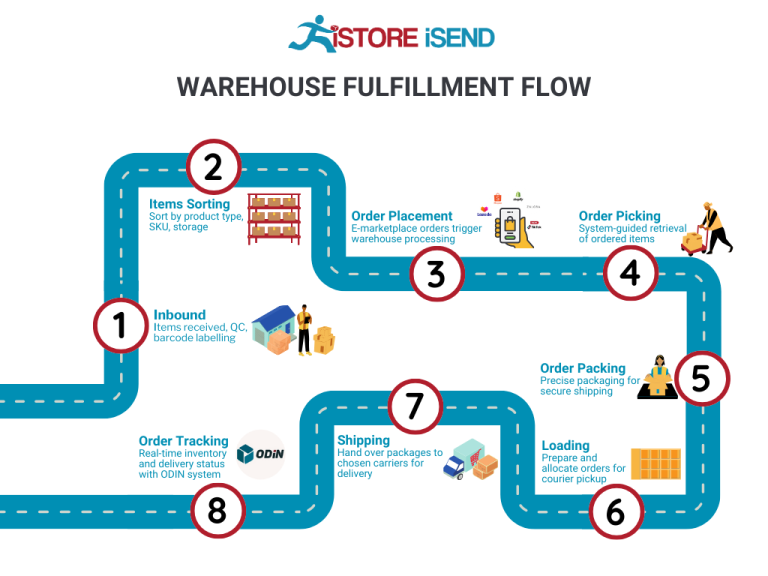
The importance of an efficient picking process cannot be understated; errors in picking can lead to customer dissatisfaction and increased return rates. Utilizing technology, such as pick-to-light systems or mobile scanning devices, can enhance picking accuracy and speed. Additionally, training warehouse staff to follow best practices can further reduce errors and improve overall fulfillment efficiency.
4. Order Packing
After items are picked, they move to the packing stage. This step involves securely packaging the products for shipping to ensure they arrive at the customer’s location in perfect condition. Proper packing is vital as it protects items from damage during transit and contributes to a positive unboxing experience for customers. Businesses should consider using packing slips, which include order details, to ensure that the correct items are being shipped.
Choosing the right packaging materials is also important; using appropriate-sized boxes and protective materials can prevent damage while minimizing shipping costs. This is where terms like “dimensional weight pricing” come into play, as carriers may charge based on the size of the package rather than just weight. Efficient packing processes can significantly reduce shipping costs and enhance customer satisfaction through careful attention to detail.
5. Shipping & Delivery
The final step in the order fulfillment process is shipping and delivery. Once orders are packed, they are labeled and sent to the appropriate carrier for delivery. This stage is crucial as it determines how quickly and efficiently customers receive their products. Businesses must choose the right shipping options based on delivery speed, cost, and reliability, often utilizing a multi-carrier shipping strategy to optimize these factors.
Tracking numbers are assigned to each shipment, allowing both the business and the customer to monitor the order’s progress. Effective communication about shipping timelines and potential delays is essential for maintaining customer trust and satisfaction. This step is where terms like “last-mile delivery” come into play, referring to the final leg of the shipping journey from the distribution center to the customer’s door. By optimizing shipping and delivery processes, businesses can enhance customer experiences and drive repeat sales.
In summary, the order fulfillment process involves several critical steps, each playing a vital role in ensuring customer satisfaction and operational efficiency. By focusing on these key areas, e-commerce businesses can scale their operations successfully while maintaining high service standards.
Comparing Fulfillment Models: In-House vs. 3PL vs. Dropshipping
Fulfillment Model Comparison
| Model | Who Handles Inventory | Best For (Business Stage) | Key Advantage | Key Disadvantage |
|---|---|---|---|---|
| In-House Fulfillment | Business Owner/Staff | Established businesses with stable demand | Complete control over inventory and shipping | High overhead costs and operational complexity |
| Third-Party Logistics (3PL) | Third-party logistics provider | Growing businesses looking to scale | Reduced operational burden and flexibility | Less control over inventory and potential service variability |
| Dropshipping | Supplier/Manufacturer | Startups and small businesses | Low upfront investment and no inventory risk | Lower profit margins and potential shipping delays |
In-House Fulfillment
In-house fulfillment involves managing the entire logistics process within the business itself. This model is typically adopted by established businesses that have a stable demand and sufficient resources to maintain their own warehouses and staff. The key advantage of in-house fulfillment is the complete control it offers over inventory management, order processing, and shipping. Businesses can implement their own quality control measures, customize packaging, and ensure that customer service aligns with their brand values.
However, this model comes with significant disadvantages. Operating an in-house fulfillment center requires a considerable investment in infrastructure, including warehousing, technology, and labor. Additionally, managing logistics can divert focus from core business activities, leading to operational complexities. Businesses must also be prepared for fluctuations in demand, which can result in excess inventory or stockouts.
Third-Party Logistics (3PL)
Third-party logistics (3PL) providers offer a solution for businesses looking to outsource their fulfillment operations. This model is particularly beneficial for growing businesses that need to scale without the burden of managing logistics themselves. 3PL providers handle storage, inventory management, order processing, and shipping on behalf of the business. This allows e-commerce owners to focus on their core competencies, such as marketing and product development.
The main advantage of using a 3PL is the reduced operational burden. Businesses can leverage the provider’s expertise, technology, and infrastructure, allowing for greater flexibility and scalability. Additionally, many 3PLs offer advanced logistics solutions, such as real-time tracking and automated inventory management.
However, outsourcing fulfillment does come with downsides. Businesses may experience less control over their inventory and shipping processes, which can lead to inconsistencies in service quality. There is also the potential for additional costs, as 3PL services can vary widely in pricing structures. Businesses must carefully vet their 3PL partners to ensure they align with their service expectations.
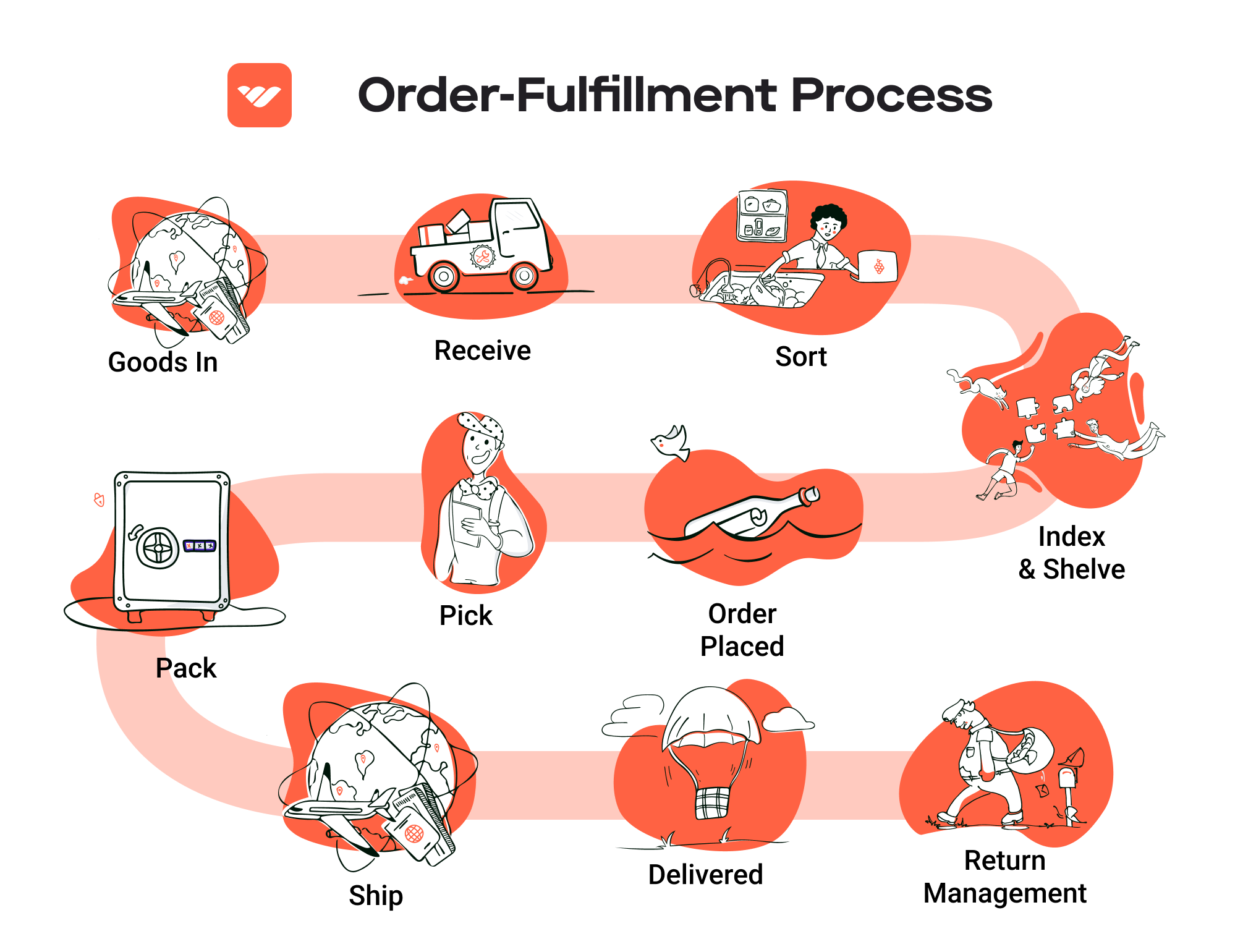
Dropshipping
Dropshipping is a fulfillment model where the retailer does not hold any inventory but instead relies on suppliers to ship products directly to customers. This model is ideal for startups and small businesses with limited capital, as it requires little to no upfront investment in inventory. Retailers can offer a wide range of products without the financial burden of purchasing stock upfront.
The primary advantage of dropshipping is the low barrier to entry. Entrepreneurs can test new products without significant financial risk and scale their operations quickly. Additionally, dropshipping eliminates the need for warehousing and fulfillment logistics, allowing business owners to focus on marketing and customer service.
However, dropshipping also presents challenges. Profit margins can be lower compared to other fulfillment models since retailers often pay a premium for the convenience of not handling inventory. Moreover, shipping times can be longer and less predictable, which may lead to customer dissatisfaction. Retailers also have limited control over product quality and inventory levels, which can affect their brand reputation.
In conclusion, choosing the right fulfillment model depends on various factors including business size, stage of growth, and operational capabilities. Each model has its unique advantages and disadvantages, and businesses must assess their specific needs and resources to determine the best fit for their logistics strategy.
A Deep Dive into Amazon FBA: Pros, Cons, and Who It’s For
Understanding Fulfillment by Amazon (FBA)
Fulfillment by Amazon (FBA) is a service that allows e-commerce businesses to outsource their logistics and customer service to Amazon. Through FBA, sellers can store their products in Amazon’s fulfillment centers, and when a customer places an order, Amazon handles the storage, packing, shipping, and customer service. This solution can be particularly appealing for businesses looking to scale their operations without the overhead of managing their own warehousing and shipping processes.
How FBA Works
-
Product Listing and Enrollment: Sellers begin by creating an Amazon seller account and listing their products. During the listing process, they can choose to enroll their products in FBA.
-
Shipping to Amazon: Once enrolled, sellers are instructed on how to send their inventory to designated Amazon fulfillment centers. This can involve shipping products in bulk or individually, depending on the seller’s inventory management strategy.
-
Storage and Management: Products are stored in Amazon’s warehouses. Amazon takes responsibility for managing the inventory, including tracking stock levels and ensuring that items are available for fulfillment.
-
Order Fulfillment: When a customer places an order, Amazon picks, packs, and ships the product directly to the customer. This includes handling returns and customer inquiries related to the order.
-
Customer Service: Amazon also manages customer service for FBA orders, which can help enhance customer satisfaction and trust.
-
Reporting and Analytics: Sellers have access to detailed reports and analytics through their Amazon Seller Central account, enabling them to monitor sales performance and inventory levels.
Pros of Amazon FBA
1. Prime Eligibility
One of the significant advantages of using FBA is that products become eligible for Amazon Prime, which can lead to increased sales. Prime members are more likely to purchase items that offer free two-day shipping, enhancing your product’s visibility and attractiveness.
2. Customer Trust
Amazon has established a strong brand reputation, and customers often feel more secure purchasing items fulfilled by Amazon. This trust can translate into higher conversion rates for sellers who utilize FBA.
3. Multi-Channel Fulfillment
FBA is not limited to sales through Amazon. Sellers can use FBA to fulfill orders from their own websites or other sales channels, streamlining logistics across multiple platforms. This flexibility allows businesses to reach a broader audience without the complexities of managing different fulfillment processes.
4. Time and Resource Savings
By outsourcing logistics and customer service, sellers can focus on other critical aspects of their business, such as product development and marketing. This can lead to improved efficiency and the ability to scale operations more quickly.
5. Simplified Returns Process
FBA also simplifies the returns process. Amazon handles returns on behalf of sellers, making it easier for customers to return items, which can improve overall customer satisfaction.
Cons of Amazon FBA
1. High Fees
One of the primary drawbacks of FBA is the cost. Sellers are required to pay storage fees for the space their products occupy in Amazon’s warehouses, as well as fulfillment fees for each order processed. For sellers with low-margin products or small sales volumes, these costs can significantly eat into profits.
2. Strict Inventory Rules
Amazon has strict inventory management policies, including limits on how much inventory can be sent to their warehouses. Sellers must be diligent in managing their stock levels and may face penalties for excessive inventory that does not sell.
3. Commingling Risks
FBA utilizes a commingling system where inventory from different sellers may be stored together. This can lead to issues if a customer receives a defective product or if there are discrepancies in inventory. Sellers may have difficulty tracking their specific inventory and may face challenges in managing quality control.
4. Loss of Control
When using FBA, sellers relinquish some control over the customer experience. While Amazon manages customer service, sellers may have limited input on how their brand is represented and how issues are resolved.
5. Long-Term Storage Fees
If products do not sell within a certain timeframe, sellers may incur long-term storage fees. This can be particularly problematic for seasonal items or products with unpredictable demand.
Who is FBA Best For?
Fulfillment by Amazon is particularly well-suited for:
-
Small to Medium-Sized Businesses: Companies that lack the resources to manage their own logistics can benefit significantly from FBA, allowing them to compete with larger players in the market without substantial investments in warehousing and shipping.
-
E-commerce Entrepreneurs: New sellers looking to enter the market can leverage Amazon’s extensive infrastructure and customer base to gain visibility and traction quickly.
-
Businesses with High Sales Volume: Sellers who anticipate a high volume of sales can benefit from the economies of scale that FBA offers, reducing per-order fulfillment costs.
-
Brands Seeking to Increase Trust: Businesses that may not yet have established a strong brand presence can benefit from the trust associated with Amazon, attracting more customers through Prime eligibility.
-
Multi-Channel Sellers: Brands that sell across various platforms and want to streamline their fulfillment processes can utilize FBA for efficient order management.
In conclusion, while Fulfillment by Amazon offers numerous advantages that can significantly streamline operations and enhance sales potential, it is crucial for sellers to weigh these benefits against the potential drawbacks. By understanding how FBA works and evaluating whether it aligns with their business goals, e-commerce entrepreneurs can make informed decisions about leveraging this powerful fulfillment solution.
Core Services Offered by Fulfillment Centers
Inventory Management & Warehousing
Inventory management and warehousing are fundamental services provided by fulfillment centers, designed to streamline the storage and organization of products. Fulfillment centers utilize advanced inventory management systems that allow businesses to monitor stock levels in real-time, ensuring that products are readily available when needed. This involves tracking the movement of goods, managing stock replenishment, and optimizing storage space.
The benefits of effective inventory management are numerous. For e-commerce businesses, it means reduced holding costs and minimized risk of stockouts or overstocking. With accurate inventory data, companies can forecast demand more accurately, leading to better purchasing decisions and improved cash flow. Moreover, fulfillment centers often offer climate-controlled storage options for sensitive products, further protecting inventory integrity. This level of control and visibility into inventory can significantly enhance operational efficiency and customer satisfaction.
Pick and Pack Services
Pick and pack services are at the heart of the fulfillment process. This service involves selecting products from the warehouse (picking) and then packaging them appropriately for shipment (packing). Fulfillment centers employ efficient picking systems—like batch picking or wave picking—to streamline the process and reduce order fulfillment time. Once items are picked, they are carefully packed to prevent damage during transit, using appropriate materials and methods.
The primary benefit of pick and pack services for e-commerce businesses is the speed and accuracy they bring to order fulfillment. Quick turnaround times improve customer experience and can lead to increased customer loyalty. Additionally, outsourcing these services to a fulfillment center allows e-commerce businesses to focus on core activities such as marketing and product development, rather than the logistical challenges of order processing. This can be especially advantageous during peak seasons, where order volumes can surge unexpectedly.
Kitting and Assembly
Kitting and assembly services involve grouping individual items into ready-to-sell packages or assembling products before shipping. This can range from simple bundling of products (e.g., a set of kitchen utensils) to complex assembly tasks (e.g., putting together furniture). Fulfillment centers often have specialized teams equipped with the tools and expertise necessary to perform these tasks efficiently.
For e-commerce businesses, kitting and assembly services offer several advantages. First, they allow for the creation of value-added products that can differentiate a brand in a competitive market. Bundled products can increase average order value, while assembled goods often command higher prices due to perceived convenience. Furthermore, outsourcing these tasks frees up internal resources, allowing businesses to scale operations without the need to invest in additional labor or space. This flexibility is crucial for adapting to changing market demands and consumer preferences.
Returns Management (Reverse Logistics)
Returns management, also known as reverse logistics, refers to the process of handling product returns from customers. Fulfillment centers provide a comprehensive returns management service that includes receiving returned items, inspecting their condition, restocking them if possible, or processing them for disposal or recycling. They may also handle customer communications regarding returns, making the process seamless for both the business and its customers.
The importance of effective returns management cannot be overstated. For e-commerce businesses, a smooth return process can enhance customer satisfaction and foster trust, encouraging repeat purchases. Additionally, efficient returns management minimizes the financial impact of returns on the business. By quickly restocking or repurposing returned items, businesses can recover lost revenue and maintain healthier inventory levels. Furthermore, data collected from returns can provide valuable insights into product quality and customer preferences, enabling businesses to make informed decisions about product offerings and marketing strategies.
Conclusion
In summary, fulfillment centers offer a suite of core services that are essential for scaling e-commerce operations. From managing inventory and streamlining the pick and pack process to providing kitting and assembly services, as well as efficient returns management, these services allow businesses to optimize their logistics and focus on growth. By leveraging the expertise and resources of fulfillment centers, e-commerce businesses can enhance operational efficiency, improve customer satisfaction, and ultimately drive sales.
How to Choose a Fulfillment Partner: A 6-Point Checklist
Location & Warehouse Network
Importance:
The geographic location of a fulfillment partner’s warehouses can significantly impact shipping costs and delivery times. The closer the warehouses are to your customer base, the more efficient and cost-effective your logistics will be. This is especially crucial for e-commerce businesses that rely on quick delivery to stay competitive.
Questions to Ask:
– Where are your warehouses located, and how do you decide on new locations?
– Can you provide details on your shipping zones and how they affect transit times?
– Do you have a network of warehouses that can support our business across multiple regions or countries?
Technology & Integrations
Importance:
In today’s digital landscape, seamless technology integration is vital for efficient operations. Your fulfillment partner should offer robust technology solutions that integrate smoothly with your e-commerce platform, inventory management systems, and other critical tools. This ensures real-time tracking, inventory updates, and streamlined order processing.
Questions to Ask:
– What technology do you use for order management, and how does it integrate with platforms like Shopify, WooCommerce, or Amazon?
– Do you provide an API for custom integrations?
– Can you demonstrate how your system handles inventory tracking and order fulfillment?
Specializations (e.g., Cold Storage, Oversized Items)
Importance:
Depending on your product type, you may require a fulfillment partner with specialized capabilities. For instance, if you sell perishable goods, a partner with cold storage facilities is essential. Similarly, if you deal with oversized items, ensure the partner has the necessary infrastructure to handle such products.
Questions to Ask:
– What types of products do you specialize in handling?
– Do you have the capability to store and manage temperature-sensitive items?
– How do you handle unique packaging or shipping requirements for oversized or fragile items?
Scalability & Capacity
Importance:
As your business grows, your fulfillment needs will evolve. It’s crucial to partner with a 3PL that can scale its operations in line with your growth. This includes not only physical space but also workforce capacity and technology resources to manage increased order volumes.
Questions to Ask:
– How do you manage seasonal spikes in order volume?
– Can you provide examples of how you’ve scaled operations for other clients?
– What processes do you have in place to ensure capacity during peak seasons?
Pricing and Contracts
Importance:
Understanding the pricing structure of your fulfillment partner is vital to maintaining profitability. Look for transparency in their pricing model, including any hidden fees associated with storage, pick and pack, shipping, or returns. Additionally, review contract terms to ensure they align with your business goals.
Questions to Ask:
– Can you provide a detailed breakdown of your pricing model?
– Are there any additional fees we should be aware of, such as for storage or handling?
– What are the terms for contract termination or changes in service?
Customer Support & Reviews
Importance:
Exceptional customer support can make a significant difference in your experience with a fulfillment partner. Look for a partner that offers responsive, knowledgeable support. Additionally, researching reviews and testimonials can provide insights into the partner’s reliability and service quality.
Questions to Ask:
– What level of customer support do you provide, and how can we reach you?
– Can you share testimonials or case studies from businesses similar to ours?
– How do you handle issues or disputes that arise during the fulfillment process?
Conclusion
Choosing the right fulfillment partner is a critical decision that can greatly influence your e-commerce business’s efficiency and customer satisfaction. By using this checklist, you can systematically evaluate potential partners against key criteria that align with your operational needs. Take the time to ask the right questions and ensure you choose a partner that can grow with your business and meet your unique logistics requirements.
Understanding Fulfillment Pricing: A Breakdown of Common Fees
Initial Setup Fees
When you first engage a fulfillment center like Amazon FBA, you may encounter initial setup fees. These fees cover the costs associated with establishing your account, including onboarding processes and system integration. The setup fee can vary based on the complexity of your business needs, such as whether you require specialized software or training for your staff.
Calculation:
Typically, the setup fee is a one-time charge that can range from a few hundred to several thousand dollars, depending on the services you choose. To get a precise estimate, inquire about the specific services included in the setup process and any potential additional costs.
Receiving Fees
Receiving fees are charged when your products arrive at the fulfillment center. This fee compensates the facility for the labor and resources needed to unload, inspect, and store your goods. These fees can vary based on the type and volume of goods being processed.
Calculation:
Receiving fees are generally calculated per unit or per pallet, with costs ranging from $0.50 to $5.00 per item or pallet. The total fee will depend on the quantity and size of your shipment. To optimize this cost, consider consolidating shipments and ensuring that your products are correctly labeled to facilitate quicker processing.
Storage Fees (per pallet/bin)
Storage fees are incurred for keeping your products in the fulfillment center. These fees are essential to cover the costs of warehouse space, inventory management, and security. The fees can vary based on the storage duration and the volume of space your products occupy.
Calculation:
Storage fees are typically calculated on a monthly basis and can range from $10 to $30 per pallet or bin. In some cases, fees may also be assessed based on cubic feet of space used. To manage storage costs effectively, aim to maintain optimal inventory levels and avoid excessive long-term storage, which can incur additional charges.
Pick & Pack Fees (per item/order)
Pick and pack fees cover the costs associated with retrieving items from storage, packing them for shipment, and preparing them for delivery. This fee is crucial for order fulfillment and varies based on the complexity of the order.
Calculation:
Pick and pack fees are generally charged per item and can range from $1.00 to $5.00, depending on the fulfillment center’s policies and the specific requirements of your order (e.g., special packaging, kitting). To reduce these costs, consider streamlining your product offerings and minimizing customization requests that may complicate the picking process.
Shipping Fees
Shipping fees are the costs associated with transporting your products from the fulfillment center to your customers. This is often one of the most significant costs in e-commerce operations and can vary widely based on destination, weight, and shipping method.
Calculation:
Shipping fees can be calculated based on a variety of factors, including weight, dimensions, destination, and service level (standard, expedited, etc.). Fulfillment centers may offer discounted shipping rates, especially for high-volume shippers. To optimize shipping costs, leverage shipping calculators provided by fulfillment services and consider negotiating rates based on your expected shipping volume.
Conclusion and Tips for Accurate Quotes
To ensure you receive an accurate quote for fulfillment services, follow these practical tips:
-
Understand Your Needs: Clearly outline your operational requirements, including the types of products you sell, your expected order volume, and any special handling needs.
-
Request Detailed Quotes: When seeking quotes, ask for itemized breakdowns of all potential fees. This transparency will help you compare different fulfillment options effectively.
-
Negotiate Rates: Don’t hesitate to negotiate fees, especially if you anticipate high shipping volumes or long-term commitments. Fulfillment centers may offer discounts for bulk orders or consistent business.
-
Monitor Your Costs: Regularly review your fulfillment expenses to identify areas for cost savings. Adjust your inventory management and shipping strategies based on sales trends and customer demand.
-
Stay Informed: Keep abreast of any changes in fulfillment pricing models or policies at your chosen fulfillment center, as these can impact your overall costs.
By understanding these common fulfillment pricing models and following these tips, you can better manage your logistics costs and scale your e-commerce operations effectively.
Frequently Asked Questions (FAQs) about Fulfillment
1. What is the bfi7 Amazon Fulfillment Center?
The bfi7 Amazon Fulfillment Center, located in the United States, is one of Amazon’s facilities dedicated to storing and shipping products for sellers using Fulfillment by Amazon (FBA). This center plays a critical role in ensuring efficient inventory management, order processing, and fast delivery to customers.
2. How does the bfi7 fulfillment center benefit e-commerce businesses?
Utilizing the bfi7 fulfillment center allows e-commerce businesses to leverage Amazon’s logistics network, which includes rapid shipping options, advanced inventory management systems, and access to Amazon Prime members. This can significantly enhance customer satisfaction and increase sales volume.
3. What is the difference between a warehouse and a fulfillment center?
A warehouse primarily focuses on storing goods and may not handle order processing or shipping. In contrast, a fulfillment center, like the bfi7, is designed specifically to manage the entire order fulfillment process—from receiving inventory and storing products to picking, packing, and shipping orders directly to customers.
4. What is a 3PL?
A 3PL, or third-party logistics provider, is a company that offers logistics services to businesses, including warehousing, inventory management, and order fulfillment. While Amazon’s fulfillment centers operate as a 3PL for sellers using FBA, other 3PLs may offer different services tailored to specific business needs.
5. How much do fulfillment services cost?
Fulfillment services typically involve various costs, including storage fees, picking and packing fees, and shipping costs. For Amazon’s FBA, fees can vary based on the size and weight of the products, as well as the time of year. It’s essential for businesses to evaluate their specific needs and calculate costs accordingly to determine profitability.
6. What types of products can be fulfilled through the bfi7 center?
The bfi7 fulfillment center can handle a wide range of products, from small items like electronics and accessories to larger products like home goods and furniture. However, certain restricted items, such as hazardous materials or perishables, may not be eligible for fulfillment through Amazon.
7. What is the typical processing time for orders at the bfi7 fulfillment center?
The processing time for orders at the bfi7 center generally ranges from 24 to 48 hours, depending on order volume and product availability. Amazon aims to expedite the shipping process, particularly for Prime members, where same-day or next-day delivery options may be available.
8. How do I track my inventory at the bfi7 fulfillment center?
Sellers can track their inventory through the Amazon Seller Central dashboard. This platform provides real-time updates on inventory levels, order status, and any potential issues with stock levels. Regular monitoring is crucial for maintaining optimal inventory levels and avoiding stockouts.
9. What should I do if there are issues with my orders at the bfi7 center?
If issues arise with orders fulfilled through the bfi7 center, sellers should contact Amazon Seller Support for assistance. Common issues might include lost packages, damaged items, or discrepancies in inventory. Prompt communication is essential to resolve these matters efficiently.
10. How can I optimize my fulfillment strategy using the bfi7 center?
To optimize your fulfillment strategy, consider the following steps:
– Analyze your sales data to understand demand patterns and adjust inventory levels accordingly.
– Utilize Amazon’s inventory management tools to automate stock replenishment.
– Consider using Amazon’s multi-channel fulfillment services if selling on other platforms to streamline operations.
– Regularly assess fulfillment costs and performance metrics to make informed decisions about your logistics strategy.
By effectively leveraging the capabilities of the bfi7 fulfillment center, you can enhance your overall e-commerce operations and improve customer satisfaction.
Conclusion: Is Outsourcing Fulfillment the Right Move for Your Business?
Evaluating the Benefits of Outsourcing Fulfillment
Outsourcing your fulfillment can be a transformative decision for your e-commerce business. By leveraging a fulfillment service, you can save significant time and resources, allowing you to focus on core business activities such as marketing, product development, and customer engagement. Fulfillment partners, especially those integrated with platforms like Amazon, have established systems that streamline order processing, inventory management, and shipping logistics. This efficiency can translate to faster delivery times, which is crucial in today’s competitive market.
Scalability is another compelling reason to consider outsourcing. As your business grows, so too do the complexities of your logistics operations. A capable fulfillment partner can easily adapt to increased order volumes, seasonal fluctuations, and expanding product lines. This flexibility ensures that you can meet customer demand without the need to invest heavily in infrastructure or personnel.
Moreover, fulfillment services bring expertise that may not be available in-house. Experienced logistics providers understand the nuances of shipping regulations, international tariffs, and inventory management. Their industry knowledge can help you navigate challenges that could otherwise hinder your growth.
However, the success of outsourcing fulfillment hinges on selecting the right partner. Conduct thorough research to ensure that their capabilities align with your business goals and that they can support your expansion plans. Look for partners with proven track records, positive customer reviews, and robust technology integrations.
Take Action
To determine if outsourcing fulfillment is the right next step for your business, conduct a comprehensive audit of your current shipping processes. Analyze pain points, costs, and time commitments involved in your logistics operations. This assessment will guide you in making an informed decision about whether a fulfillment partner can unlock your business’s growth potential.
Important Disclaimer
⚠️ Important Disclaimer
The information in this guide is for educational purposes. Fulfillment services, pricing, and platform features change frequently. Always conduct your own due diligence and consult with providers directly before making business decisions.
